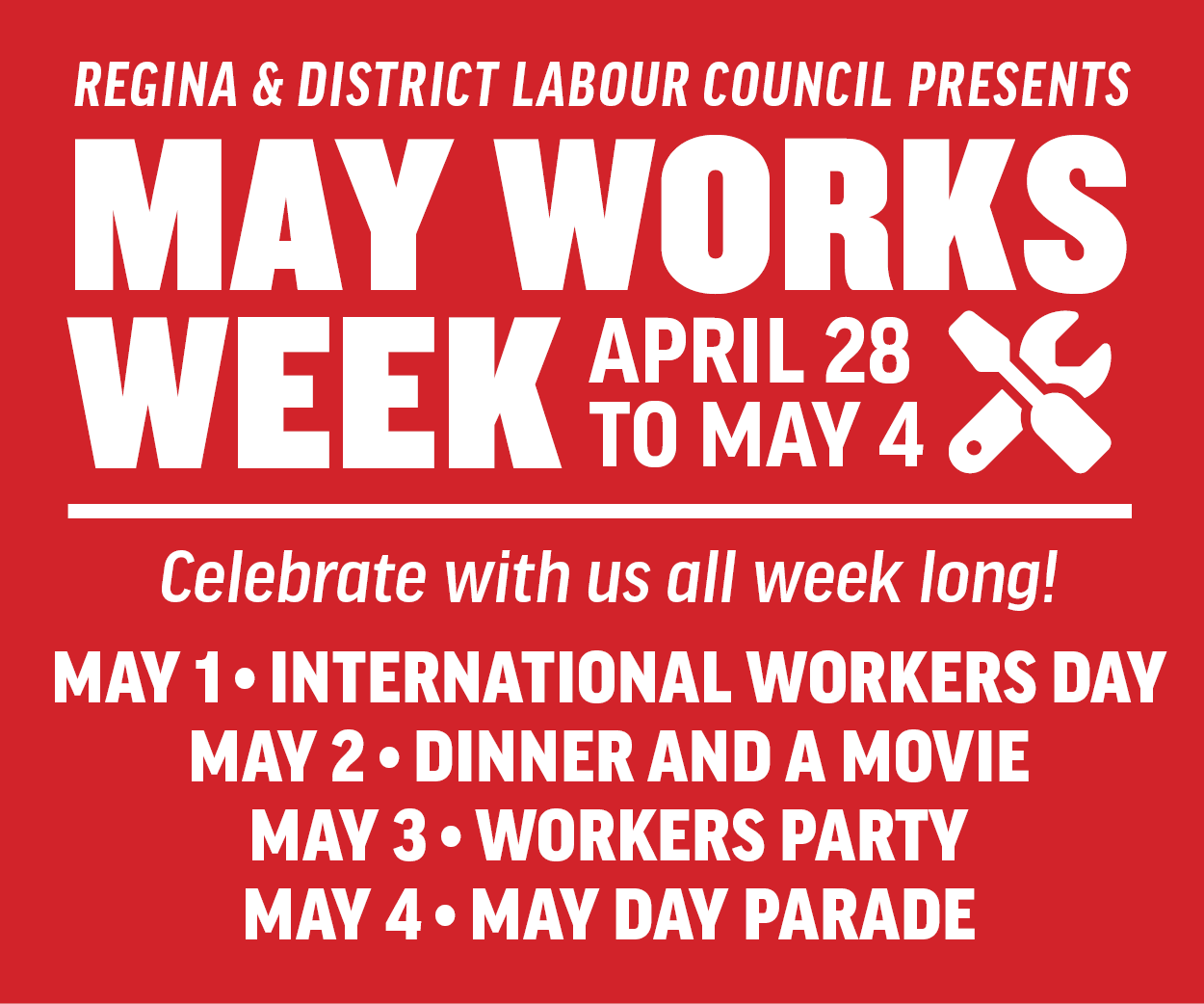Prairie Interlace’s rugs and tapestries await contemplation
Art | Gregory Beatty

Prairie Interlace: Weaving, Modernisms and the Expanded Frame
MacKenzie Art Gallery
Until Feb. 18
Prairie Interlace: Weaving, Modernisms and the Expanded Frame features an amazing array of 61 textile works by 48 artists.
It starts with a story about clay, MacKenzie Gallery curator Timothy Long recounted at an opening night conversation with co-curators Michele Hardy (Nickle Galleries, Calgary) and Julia Krueger (Independent).
Krueger has a passion for craft, and Long credited her with inspiring his desire to collaborate on major projects involving craft media — most recently, Regina ceramist Victor Cicansky’s 2019 retrospective The Gardener’s Universe.
“After that show, we looked at each other and said ‘Well, what’s next?’” Long recalled. “Julia looked at me and said, ‘What about textiles?’ I replied, ‘Yeah, we got a few. Let’s do something’.”
One work in the MacKenzie permanent collection leapt instantly to Long’s mind: the late Saskatchewan artist Kaija Sanelma Harris’ iconic Sun Ascending (1985), a 24-panel, 20-metre-long weaving Harris created for the Mies van der Rohe designed TD Bank Tower in Toronto.
“It’s a piece that sent me off on a journey of discovery,” says Long.
Michele Hardy echoed that sentiment during her presentation.
“Together as curators, we pondered given the monumental scale and sophistication of Sun Ascending, what else was out there? Who else was working with fibre on the prairies?” she said.
Experimentation and Exuberance
The first realization the curatorial team came to was that to make the exhibition manageable, they needed to narrow the focus.
“Choices were heartbreakingly difficult. But we decided to focus on weaving and interlace practices such as macramé, rug-hooking and crochet, setting aside embroidery, quilting, garment construction and felt-making,” says Hardy.
“We also chose to focus on works created for display and contemplation, as opposed to works created to serve more utilitarian purposes,” she says.
Another trim the curators made was to limit the show to the period 1960–2000 — which in art circles (visual, architecture, dance and more) covers both Modernism and postmodernism.
“Modernism is often characterized as a philosophical movement encouraging artists and other great thinkers to break from tradition, embrace new technologies, question assumptions, and experiment with form, materials and techniques,” said Hardy.
Once the team began their search for work to include in the show, they quickly discovered the same held true in the textile arts.
“It was clear that the second half of the 20th century had seen an explosion of innovative textile-based art on the prairies. Though many learned to weave traditionally, experimentation and exuberance were widely embraced,” says Hardy.
Not that the search was an easy one, Julia Krueger noted during her talk.
“The pandemic disrupted our plans to visit archives and collections. Instead, we had to comb through data bases, or rely on staff who were allowed to enter locked down facilities,” says Krueger.
“Inconvenient as it was, it shone a spotlight on the challenges of storing, documenting, studying and exhibiting textiles — challenges that we believe stifle and suppress textile research, even when there isn’t a pandemic,” she says.
Krueger drove home her point by comparing how paintings and textiles are stored in permanent collections. Paintings are on racks and relatively easy to view, while textiles are rolled up, and generally involve a fair bit of work to unroll and view, so researchers must rely on online images which may be missing or of poor quality.
As they curated work for the show, four themes emerged: Elemental Landscapes, Working on and off the Grid, Soft Power and Body Politics.
Speaking of the first two, Hardy said, “There is a resonance between the grid of modernist art, the survey grid of the prairie landscape, and the ordered grid of the loom. Some artists questioned conventions of both craft and art, which lead to experiments with off loom practices that move into three dimensions: leather, rabbit skin, spun dog hair, machine shrunken fabrics, even condoms.”
Yes, experimentation went as far as condoms, which Nancy Crites used to create Threshold: No Laughing Matter (1991) — a hooked rug done at the height of the AIDS epidemic. Crites’s work also serves as a reminder of postmodernism’s influence in the show.
Ann Newdigate’s tapestries decrying apartheid policies in her South African homeland and against Indigenous people in Canada; and Katherine Dickerson’s West Coast Tree Stump (1972), with its painful evocation of old growth logging through a two-metre-tall stump made of brown wool, are other examples of politically engaged art characteristic of postmodernism.
Body Politics and Soft Power are two themes that are especially relevant here.
“Beginning in the 1970s, artists openly embraced fibre’s relationship to craft while also challenging the hierarchical and gender-based art and craft divide,” says Hardy. “Responding to successive waves of feminism, artists produced works which celebrated women’s bodies and experiences as well as engaging in critical discourses around gender.”
Soft Power, as a theme, explores the relationship between textile art and architecture. As Hardy explained in her talk, “During this period, fibre arts were routinely sought after by interior designers and architects to soften the stark, cold interiors of modernist buildings. Numerous monumental commissions were produced which brought the traditions and landscapes of the prairies into centres of financial and cultural power.”
Although it was a problematic relationship, Krueger cautioned in her talk.
“Architectural textiles have been understood to be subordinate to architecture. Apart from the logistical and technical challenges of creating textiles for these settings, their servitude does not end with their removal from the space. To put it bluntly, they can’t always simply be moved and reinstalled in a gallery or other building because they are often site-specific and very large.”
Harris’s Sun Ascending is undoubtedly a highlight of the exhibition. Another iconic architectural tapestry is Marge Yuzicappi’s Ta-Hah-Sheena (1970) which was commissioned by the University of Regina for the Minoru Yamasaki-designed Library building which opened in 1967.
But really, there are many highlights in this exhibition, which is literally a feast for the eyes. Although the sensory appeal doesn’t stop with the visual, Krueger argued persuasively in her talk.
“Because humans routinely handle textiles, when we look at textile art, we imagine ourselves touching it. This creates what we call haptic sympathy, so when we view a work, we conceptually imagine touching it,” she says.
That haptic sympathy, she further argued, generates a stickiness that encourages people to engage more deeply, even with the Modernist work which, like better known Modernist paintings and sculptures, tended toward Minimalism and formal elements like line, colour, shape and texture.
“The malleability of the cloth, draping, folding, squishing, shrinking, they are all conceptually significant aspects of fibre art,” says Krueger, pointing to Aganethea Dyck’s Close Knit (1976)
The work consists of over 30 wool sweaters which Dyck shrunk in size (using a wringer washer), then arranged in a huddled row. The installation was inspired by the story of her Mennonite grandmother who was forced to flee war with the rest of her community — everyone wearing as much clothing as possible, both to save the clothing for future use, and keep warm.
“That’s the power of craft. It encourages you to ‘lean in’ to your haptic sympathy and imagine what it would be like to touch or use a piece for its intended purpose rather than just visually analyze something as you would a painting. Doing so will give you a conceptually richer understanding of the work, one that is felt in your body,” says Krueger. ■





